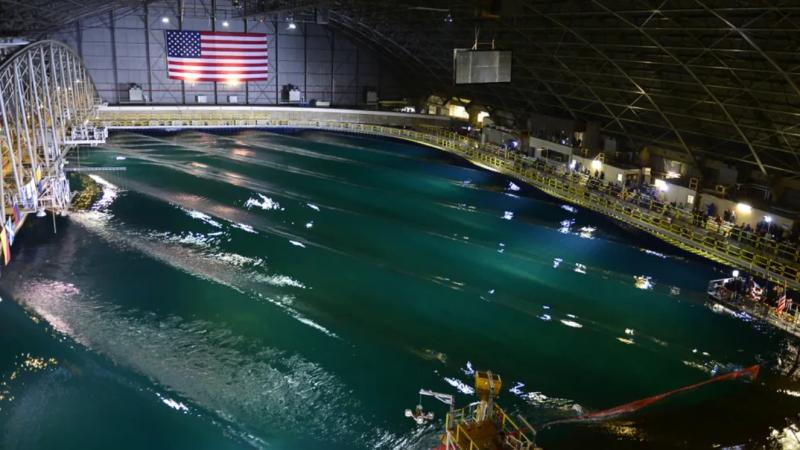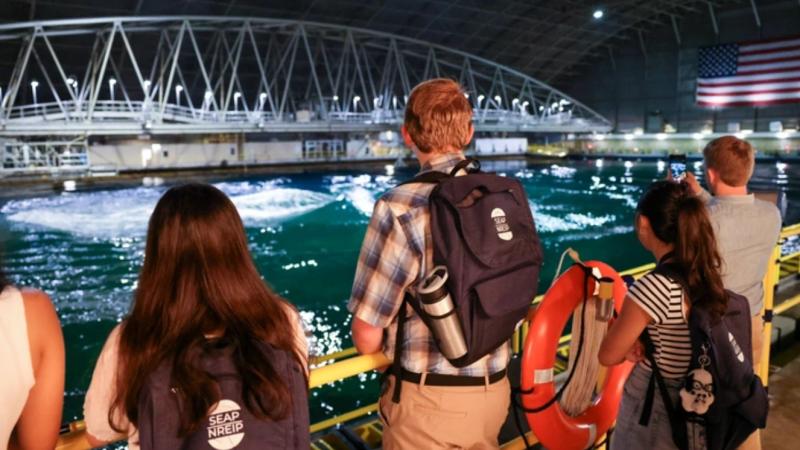NAVY'S INDOOR OCEAN: TRANSFORMING SHIP TESTING

It’s not a secret that the ocean is a vast pool of water on our Earth, and we also know that a percentage of it is still unexplored because of the huge waves, lightning all around, typhoons, and more that make vessels impossible to navigate through such areas.
The thing is, the Navy can’t really use the actual ocean to test how ships and submarines would perform in different sea conditions because they would be risking a lot of money spent on prototypes, and even lives. But now that has changed with the introduction of very advanced technology, known as the Navy's Indoor Ocean. Keep reading to learn more about its mission, and how the technology is changing the future of Naval operations.
Navy's Indoor Ocean: Understanding the Testing Facility
The Navy's Indoor Ocean is a facility with a massive water pool that is larger than a football field, but smaller than the sea. It is only used for testing ships and submarines in a way that people can control it.
The Navy’s Indoor Ocean is actually called Maneuvering and Seakeeping Basin (MASK), and is located at Naval Surface Warfare Center (NSWC) Carderock, Maryland.
It was built back in 1962 and was renovated in 2013 to make sure that it had upgraded features and to enhance its capabilities.
The size of the Navy's Indoor Ocean is 240 feet wide and 360 feet long, and it holds over 12 million gallons of water. Imagine having a giant pool that recreates the ocean’s environment and creates artificial waves – it’s just amazing, right?
According to Calvin Krishen, NSWC engineer, the value of the the Navy's Indoor Ocean is two-fold:
- First, it allows the Navy to explore cutting-edge naval technology.
- Second, it benefits sailors by making ships safer and better-equipped to succeed in the Navy's mission.

Navy Indoor Ocean: Simulated Ship Testing Activities
The Indoor Ocean allows the Navy to test how the ship and submarine behave.
They wanted to do this in a controlled environment for obvious reasons, to prevent the risk of wasting resources, prototypes, and a lot of money.
If the test was conducted in the actual ocean, they couldn't predict what could potentially happen; therefore, having the tests in a controlled environment is the best approach.
The kind of models they mostly test out in the Indoor Ocean are the following:
- With and without cargo
- With and without crew simulators
- In firing and non-firing configurations
- In calm and chaotic seas
And yes, all of the tests are monitored with computer systems that the Navy has built. Once they have gathered the data in the test, they will then correct issues and ensure that the ships are ready for combat.
Additionally, the researchers in charge of the project are able to dial in the exact conditions under which the Navy's current and future vessels will operate.
"We can nail, at scale, the conditions all over the world," said Jon Etxegoien, Naval Architecture and Engineering Department head.
"So it's not just that we can do some kind of rouge sea states, we can actually do the kind of seas they can expect in the North Atlantic, the South Pacific, littoral areas, that sort of thing. So that's what gives us a real leg up. It's not just some generic sea condition, but the specifics of where they're going to be operating."
Navy Indoor Ocean Depth: Key Specifications
The Navy’s indoor ocean is about 20 to 35 feet deep. In 2013, the basin became fully operational as a new system was installed, so now they can do several simulations such as the following:
- Flat calms
- Moderate swells
- Hurricane-strength waves
- Multi-directional seas
- Typhoons
- Short-crested seas
- Different wave states at various angles
"There are many different kinds of waves," said Calvin Krishen, NSWC engineer. "Waves are different in different parts of the world, and they are different depending if you are close to shore, or away from shore, or whether you're in a storm or not. We actually have the capability of programming all those different types of waves to test."
The most interesting part is that there are also several advanced technologies that help support the mission of the Navy’s indoor ocean to have the tests done in just weeks instead of months.
These technologies include:
- Computational Fluid Dynamics (CFD)
- Finite Element Analysis (FEA)
- Virtual Reality & Digital Twins

Navy Indoor Ocean: Future Testing Challenges
Thanks to the people who have offered support, and those who have great ideas, the Navy’s Indoor Ocean was made possible. Although we are already in an era where technology is advanced, the Indoor Ocean could still face challenges in the future, as AI will likely take over the testing.
Sure, AI is likely to be extremely helpful in conducting the tests, as it would eliminate the need for human control. But the thing is, if the AI is not properly systematized, then there could be potential errors that they might face inside the Navy’s Indoor Ocean.
Read next:
- Ink, Honor, and the Armed Forces: Exploring the History of Military Tattoos
- Everything You Need to Know to Successfully Navigate the Current Military Retirement System
- These Are the Best States for Military Retirees in 2025
Sources:
BY ALLISON KIRSCHBAUM
Veteran, Military History & Culture Writer at VeteranLife
Navy Veteran
Allison Kirschbaum is a Navy Veteran and an experienced historian. She has seven years of experience creating compelling digital content across diverse industries, including Military, Defense, History, SaaS, MarTech, FinTech, financial services, insurance, and manufacturing. She brings this expertis...
Credentials
Expertise
Allison Kirschbaum is a Navy Veteran and an experienced historian. She has seven years of experience creating compelling digital content across diverse industries, including Military, Defense, History, SaaS, MarTech, FinTech, financial services, insurance, and manufacturing. She brings this expertis...



